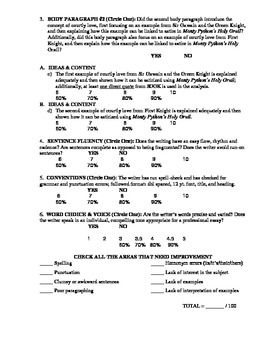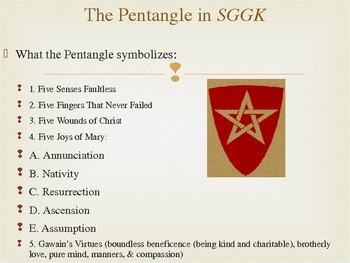Sir Gawain and the Green Knight Unit 16-Day,PPTs,FullText,Quiz,Essay,Common Core
William Woodrum
266 Followers
Grade Levels
9th - 12th
Subjects
Resource Type
Formats Included
- Zip
Pages
48 pages
William Woodrum
266 Followers
What educators are saying
This was a quick and fun unit. My students enjoyed learning about satire and they still reference this unit months after completing it. :)
Description
This is a full unit on Sir Gawain and the Green Knight, which is a classic from Middle Ages English literature. Included in this unit is a whole unit plan covering 16 days with Common Core alignment and the following:
1. PowerPoint on Sir Gawain and the Green Knight & Arthurian Legend.
2. A much easier to read modern version text of Sir Gawain and the Green Knight with in-text discussion questions at specific moments of the story.
3. Discussion question keys for the teacher.
4. A quiz over the whole text and an accompanying key.
5. Instructions on how to write an analytical essay on the satirizing of courtly love and chivalry using Monty Python and the Holy Grail, Sir Gawain and the Green Knight, and First Knight (Sean Connery, et al).
6. PowerPoint with sample paragraphs for this essay.
7. Peer Critique score sheets for the first draft of this essay.
8. Self-Evaluation sheet for the essay.
Common Core Standards Met:
II. COMMON CORE STANDARDS ALIGNMENT (Reading Literature 9-10 & 11-12):
CCSS.ELA-Literacy.RL.9-10.1 Cite strong and thorough textual evidence to support analysis of what the text says explicitly as well as inferences drawn from the text.
CCSS.ELA-Literacy.RL.9-10.2 Determine a theme or central idea of a text and analyze in detail its development over the course of the text, including how it emerges and is shaped and refined by specific details; provide an objective summary of the text.
CCSS.ELA-Literacy.RL.9-10.3 Analyze how complex characters (e.g., those with multiple or conflicting motivations) develop over the course of a text, interact with other characters, and advance the plot or develop the theme.
CCSS.ELA-Literacy.RL.11-12.1 Cite strong and thorough textual evidence to support analysis of what the text says explicitly as well as inferences drawn from the text, including determining where the text leaves matters uncertain.
CCSS.ELA-Literacy.RL.11-12.2 Determine two or more themes or central ideas of a text and analyze their development over the course of the text, including how they interact and build on one another to produce a complex account; provide an objective summary of the text.
CCSS.ELA-Literacy.RL.11-12.6 Analyze a case in which grasping a point of view requires distinguishing what is directly stated in a text from what is really meant (e.g., satire, sarcasm, irony, or understatement).
III. COMMON CORE STANDARDS ALIGNMENT (Writing 9-10 & 11-12):
CCSS.ELA-Literacy.W.9-10.9a Apply grades 9–10 Reading standards to literature (e.g., “Analyze how an author draws on and transforms source material in a specific work [e.g., how Shakespeare treats a theme or topic from Ovid or the Bible or how a later author draws on a play by Shakespeare]”).
CCSS.ELA-Literacy.W.9-10.4 Produce clear and coherent writing in which the development, organization, and style are appropriate to task, purpose, and audience.
CCSS.ELA-Literacy.W.9-10.5 Develop and strengthen writing as needed by planning, revising, editing, rewriting, or trying a new approach, focusing on addressing what is most significant for a specific purpose and audience.
CCSS.ELA-Literacy.W.9-10.2 Write informative/explanatory texts to examine and convey complex ideas, concepts, and information clearly and accurately through the effective selection, organization, and analysis of content.
CCSS.ELA-Literacy.W.9-10.2b Develop the topic with well-chosen, relevant, and sufficient facts, extended definitions, concrete details, quotations, or other information and examples appropriate to the audience’s knowledge of the topic.
CCSS.ELA-Literacy.W.9-10.2c Use appropriate and varied transitions to link the major sections of the text, create cohesion, and clarify the relationships among complex ideas and concepts.
CCSS.ELA-Literacy.W.9-10.2d Use precise language and domain-specific vocabulary to manage the complexity of the topic.
CCSS.ELA-Literacy.W.9-10.2e Establish and maintain a formal style and objective tone while attending to the norms and conventions of the discipline in which they are writing.
CCSS.ELA-Literacy.W.9-10.2f Provide a concluding statement or section that follows from and supports the information or explanation presented (e.g., articulating implications or the significance of the topic).
CCSS.ELA-Literacy.W.11-12.2 Write informative/explanatory texts to examine and convey complex ideas, concepts, and information clearly and accurately through the effective selection, organization, and analysis of content.
CCSS.ELA-Literacy.W.11-12.2b Develop the topic thoroughly by selecting the most significant and relevant facts, extended definitions, concrete details, quotations, or other information and examples appropriate to the audience’s knowledge of the topic.
CCSS.ELA-Literacy.W.11-12.2c Use appropriate and varied transitions and syntax to link the major sections of the text, create cohesion, and clarify the relationships among complex ideas and concepts.
CCSS.ELA-Literacy.W.11-12.2d Use precise language, domain-specific vocabulary, and techniques such as metaphor, simile, and analogy to manage the complexity of the topic.
CCSS.ELA-Literacy.W.11-12.2e Establish and maintain a formal style and objective tone while attending to the norms and conventions of the discipline in which they are writing.
CCSS.ELA-Literacy.W.11-12.2f Provide a concluding statement or section that follows from and supports the information or explanation presented (e.g., articulating implications or the significance of the topic).
This work is licensed under a Creative Commons Attribution-NonCommercial-NoDerivs 3.0 Unported License.
1. PowerPoint on Sir Gawain and the Green Knight & Arthurian Legend.
2. A much easier to read modern version text of Sir Gawain and the Green Knight with in-text discussion questions at specific moments of the story.
3. Discussion question keys for the teacher.
4. A quiz over the whole text and an accompanying key.
5. Instructions on how to write an analytical essay on the satirizing of courtly love and chivalry using Monty Python and the Holy Grail, Sir Gawain and the Green Knight, and First Knight (Sean Connery, et al).
6. PowerPoint with sample paragraphs for this essay.
7. Peer Critique score sheets for the first draft of this essay.
8. Self-Evaluation sheet for the essay.
Common Core Standards Met:
II. COMMON CORE STANDARDS ALIGNMENT (Reading Literature 9-10 & 11-12):
CCSS.ELA-Literacy.RL.9-10.1 Cite strong and thorough textual evidence to support analysis of what the text says explicitly as well as inferences drawn from the text.
CCSS.ELA-Literacy.RL.9-10.2 Determine a theme or central idea of a text and analyze in detail its development over the course of the text, including how it emerges and is shaped and refined by specific details; provide an objective summary of the text.
CCSS.ELA-Literacy.RL.9-10.3 Analyze how complex characters (e.g., those with multiple or conflicting motivations) develop over the course of a text, interact with other characters, and advance the plot or develop the theme.
CCSS.ELA-Literacy.RL.11-12.1 Cite strong and thorough textual evidence to support analysis of what the text says explicitly as well as inferences drawn from the text, including determining where the text leaves matters uncertain.
CCSS.ELA-Literacy.RL.11-12.2 Determine two or more themes or central ideas of a text and analyze their development over the course of the text, including how they interact and build on one another to produce a complex account; provide an objective summary of the text.
CCSS.ELA-Literacy.RL.11-12.6 Analyze a case in which grasping a point of view requires distinguishing what is directly stated in a text from what is really meant (e.g., satire, sarcasm, irony, or understatement).
III. COMMON CORE STANDARDS ALIGNMENT (Writing 9-10 & 11-12):
CCSS.ELA-Literacy.W.9-10.9a Apply grades 9–10 Reading standards to literature (e.g., “Analyze how an author draws on and transforms source material in a specific work [e.g., how Shakespeare treats a theme or topic from Ovid or the Bible or how a later author draws on a play by Shakespeare]”).
CCSS.ELA-Literacy.W.9-10.4 Produce clear and coherent writing in which the development, organization, and style are appropriate to task, purpose, and audience.
CCSS.ELA-Literacy.W.9-10.5 Develop and strengthen writing as needed by planning, revising, editing, rewriting, or trying a new approach, focusing on addressing what is most significant for a specific purpose and audience.
CCSS.ELA-Literacy.W.9-10.2 Write informative/explanatory texts to examine and convey complex ideas, concepts, and information clearly and accurately through the effective selection, organization, and analysis of content.
CCSS.ELA-Literacy.W.9-10.2b Develop the topic with well-chosen, relevant, and sufficient facts, extended definitions, concrete details, quotations, or other information and examples appropriate to the audience’s knowledge of the topic.
CCSS.ELA-Literacy.W.9-10.2c Use appropriate and varied transitions to link the major sections of the text, create cohesion, and clarify the relationships among complex ideas and concepts.
CCSS.ELA-Literacy.W.9-10.2d Use precise language and domain-specific vocabulary to manage the complexity of the topic.
CCSS.ELA-Literacy.W.9-10.2e Establish and maintain a formal style and objective tone while attending to the norms and conventions of the discipline in which they are writing.
CCSS.ELA-Literacy.W.9-10.2f Provide a concluding statement or section that follows from and supports the information or explanation presented (e.g., articulating implications or the significance of the topic).
CCSS.ELA-Literacy.W.11-12.2 Write informative/explanatory texts to examine and convey complex ideas, concepts, and information clearly and accurately through the effective selection, organization, and analysis of content.
CCSS.ELA-Literacy.W.11-12.2b Develop the topic thoroughly by selecting the most significant and relevant facts, extended definitions, concrete details, quotations, or other information and examples appropriate to the audience’s knowledge of the topic.
CCSS.ELA-Literacy.W.11-12.2c Use appropriate and varied transitions and syntax to link the major sections of the text, create cohesion, and clarify the relationships among complex ideas and concepts.
CCSS.ELA-Literacy.W.11-12.2d Use precise language, domain-specific vocabulary, and techniques such as metaphor, simile, and analogy to manage the complexity of the topic.
CCSS.ELA-Literacy.W.11-12.2e Establish and maintain a formal style and objective tone while attending to the norms and conventions of the discipline in which they are writing.
CCSS.ELA-Literacy.W.11-12.2f Provide a concluding statement or section that follows from and supports the information or explanation presented (e.g., articulating implications or the significance of the topic).
This work is licensed under a Creative Commons Attribution-NonCommercial-NoDerivs 3.0 Unported License.
Total Pages
48 pages
Answer Key
Included
Teaching Duration
3 Weeks
Report this resource to TPT
Reported resources will be reviewed by our team. Report this resource to let us know if this resource violates TPT’s content guidelines.





